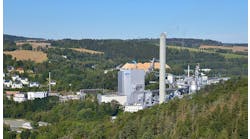Electricity and natural gas used to get little more thought from most industrial consumers than having accounting pay the bills. Not anymore.
Today, users are increasingly aware that power and energy can have huge impacts on their bottom lines, and so more manufacturers are making them part of their overall efficiency and performance optimization efforts. Several of these innovators presented their experiences and lessons learned at the "Power and Energy Management Industry Forum" this week at Automation Fair in Chicago.
New jobs for energy and users
Mary Burgoon, market development manager for power and energy at Rockwell Automation, reported that forces shaping power and energy include:
- Economic pressures to improve profitability while producing quality products at any plant worldwide at the lowest cost;
- Sustainability pressures to reduce energy consumption across all production phases, reduce emissions, and maintain brand reputations;
- Regulatory pressures to comply with current and future emissions rules; and,
- Sourcing pressures to cope with energy resource constraints, while maintaining reliability and availability.
Because of these forces, requirements of automation are changing. Effective solutions must provide asset performance management, remote monitoring and control, visualization everywhere via mobile services, and secure all these connections across their entire enterprises.
"The PEMS wouldn't need gases or spare parts, would require only minimal maintenance, and would give us better reliability because it validates every minute." Tim Bivens of Arkansas Electric Cooperative Corp. on the many advantages of predictive emissions monitoring systems vs. conventional analyzers.
"The Connected Enterprise and the Industrial Internet of Things (IIoT) can do this for the power and energy industry with data analytics that contextualize and evaluate information from increasing numbers of smart devices that are creating more things to be analyzed; cloud and virtualized computing for reliability, support and disaster recovery, which aids the shift from capital expenditures to flexible and scalable operating expenditures; and mobile workplace devices that improve access to actionable information," said Burgoon. "This enables smarter production that's more responsive to market demands, improves plant availability and reliability, allow more secure access and reduces operational costs."
Hood combines heat and power, halves costs
One company achieving greater efficiency and sustainability at the same time is the HP Hood plant in Winchester, Va., which produces about 150 million gallons of dairy and nondairy beverages per year, and recently implemented a combined heat and power (CHP) application onsite to help it reach a dairy industry initiative of reducing its greenhouse gas production by 25% by 2020. The plan was to tie the CHP to the plant's local grid, which would add some complexity, and it also had to comply with the plant's footprint restrictions and integrate with its existing steam system.
"The CHP project had to have a positive impact on both sustainability and profitability," said Jamie Ganoe, plant engineering manager at Hood. "The green had to flow both ways."
Consequently, Hood worked with ZF Energy Development, and they evaluated several designs, and settled on a natural-gas, turbine-driven generator with two boilers. It's controlled by a PlantPAx distributed control system (DCS) as well as ControlLogix PLCs and support components, which integrated well with the plant's existing Rockwell Automation architecture. System integration was performed by Valley Automation. The 20,000-hp turbine is a Solar Titan 130 with a 15-megawatt (MW) output capacity, 350-psi natural gas fueling and SoLoNOx low-emission combustion system.
"Our generator operates in parallel with the grid," explained Ganoe. Power output level is set based on real-time plant demand and energy market conditions. Synchronization with the local grid is done with automated switchgear from Basler Electric. "We started up the CHP generator this past May, and in less than a year, its impact on out energy costs is already apparent. In fact, even as our overall production has steadily increased, our total energy costs have dropped by about half. We're expecting a two- to three-year ROI, which is pretty quick for a project of this size. Also, as the project evolved, we discovered more uses for waste heat, and so we're going to be pursuing those in some future projects."
Arkansas cooperative manages emissions
Of course, even as they develop more sophisticated solutions, most power and energy applications must also maintain compliance with complex emissions rules—even as they try to upgrade to emissions control systems.
Arkansas Electric Cooperative Corp. (AECC) is owned by 17 rural cooperatives, serves 16% of the state's area and 35% of its populace, and runs two boilers, 11 combustion turbines (CTs), nine hydropower facilities, and some solar and wind applications with a collective capacity of 3,400 MWs.
To complement these assets, AECC bought its Oswald Generating Station in 2005, and began operating it in 2006. Located about 20 miles south of Little Rock, the 510-MW station is a peaker plant, which operates about 1,000 hours per year, and one of two in the U.S. with its particular combined-cycle design and configuration. It has seven CTs and two steam turbines.
AECC must continuously monitor O2, NOx and CO; control NOx with steam injection; and comply with regulations from the U.S. EPA and Arkansas Dept. of Environmental Quality (ADEQ) governing continuous emission monitoring systems (CEMS), acid rain and other standards.
"The problem was that when we bought the Oswald plant in 2005, we had to begin replacing its CEMS because it was reaching the end of its lifecycle," said Tim Bivens, technical specialist for CEMS at AECC. "We had two options, CEMS or a predictive emissions monitoring system (PEMS), but the challenge was that the EPA and ADEQ needed to recognize PEMS as equivalent to hardware CEMS for compliance." AECC was considering implementing Pavilion 8 software from Rockwell Automation as its PEMs.
"Simply replacing the CEMS with another one on the seven systems would include 21 analyzers, four PLCs, seven probes and seven sample lines, but we'd also have to pay for about 30 cylinders of calibration gases per year, plus added man-hours for maintenance, and the cost of maintaining spare parts inventory," explained Bivens. "The PEMS would require initial hardware and installation, but it wouldn't need gases or spare parts, would require only minimal maintenance, and would give us better reliability because it validates every minute."
Following this evaluation, AECC picked PEMS, but then had to submit its plan for EPA approval under 40 CFR Part 75 Subpart E regulations, and seek ADEQ approval as well. This process included performing and passing a statistical analysis of 720 hours of operational data, and delivering supporting data to the EPA along with its petition.
AECC submitted its petition in February 2013, and navigated a protracted approval process, including meeting with EPA officials in March 2013 and February 2014. The utility's PEMS petition was finally approved in March 2015, but AECC was directed to conduct one sensor test; perform quarterly relative accuracy audits (RAAs) on each unit; reestablish a grace period for compliance procedures; perform and record a daily quality assurance/quality control (QA/QC) event using PEMs validation data; and record an EPA-designated maximum emission rate (MER) for startups and shutdowns. Full implementation is imminent, as of November 2015.
"As a result, our PEMS has proven to be accurate, and it's passed six relative accuracy test audits (RATAs)," added Bivens. "We're achieving higher reliability, too." The PEMS operates on Oswald's existing plant control system instrumentation; integrates real-time weather conditions; validates all input sensors every minute; and "has saved us $50,000 per year."








